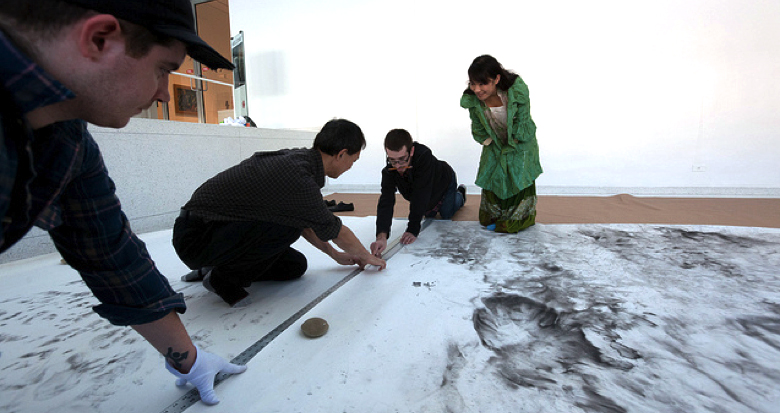| Sun | Mon | Tue | Wed | Thu | Fri | Sat |
|---|---|---|---|---|---|---|
| 1 | 2 | 3 | 4 | 5 | ||
| 6 | 7 | 8 | 9 | 10 | 11 | 12 |
| 13 | 14 | 15 | 16 | 17 | 18 | 19 |
| 20 | 21 | 22 | 23 | 24 | 25 | 26 |
| 27 | 28 | 29 | 30 | 31 |
CATEGORIES
RECENT ENTRIES
BLOG ROLL
Art flow
A commanding ink-on-rice-paper painting draws in coffee drinkers and museum visitors alike.

Walk into the Smart Museum now, and you notice, perhaps for the first time, that the back wall of the reception hall (where the café tables sit) curves at the top. Accentuating the curve is a new installation, curated by art-history professor Wu Hung, covering the entire 60-by-40-foot wall: an abstract, black-and-white landscape that suggests water and fire flowing downward—or it is upward?—in smooth waves.
The first installation in the museum’s Threshold series, Cascade will adorn the wall for more than year, through next December, explained Smart Museum director Tony Hirschel. Until then viewers can gaze at it from the café tables or lie on a futon brought in so people can look up at that concave wall and ponder the waves, splotches, and trickles. They can inspect the crinkly rice paper that artist Bingyi painted this summer in a Chinese basketball court, where it was so hot she could work only at night, Hirschel said, and where a windstorm ripped some of the panels, which Bingyi reinforced with more rice paper. She experimented with kitchen detergent and bathroom cleaner to see how they would alter the ink’s absorption into the paper.
After the panels were shipped to Chicago, Bingyi oversaw their installation last month. A Smart crew affixed the sheets to the wall with wheat paste to create what is thought to be the largest rice-paper ink painting ever made. The result: from every angle, Cascade reveals something new.
Amy Puma
Artist Bingyi oversees a Smart installation crew measuring Cascade's rice-paper panels.
December 1, 2010
